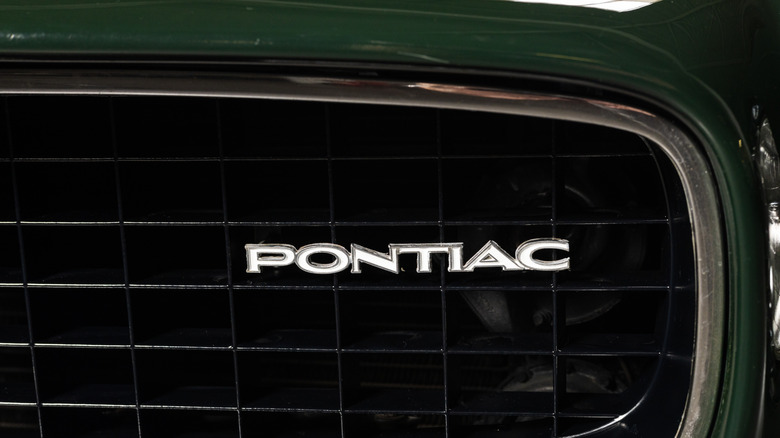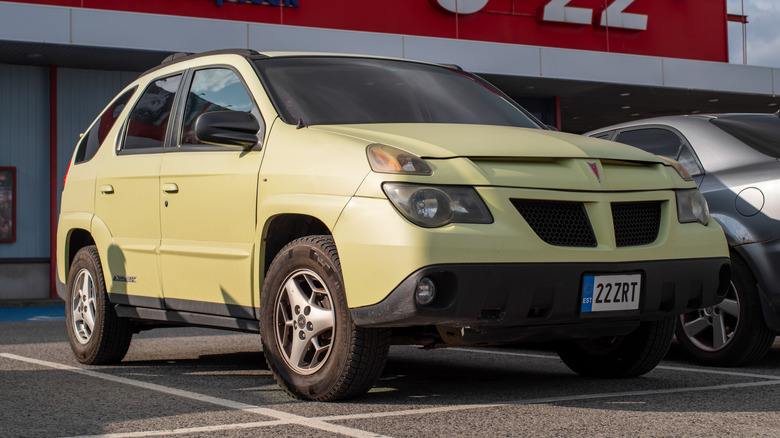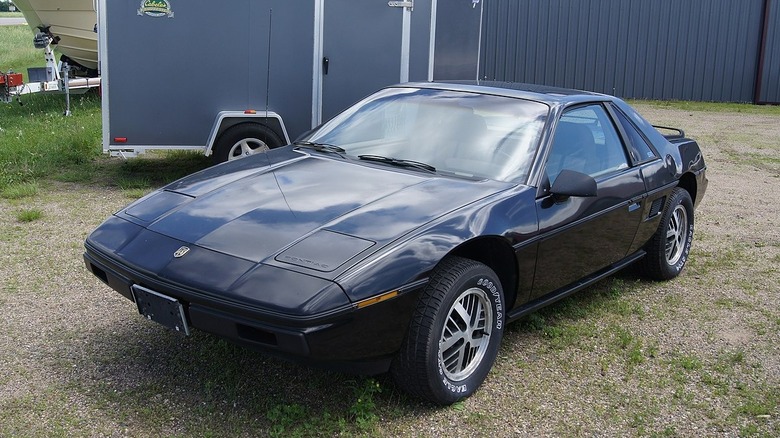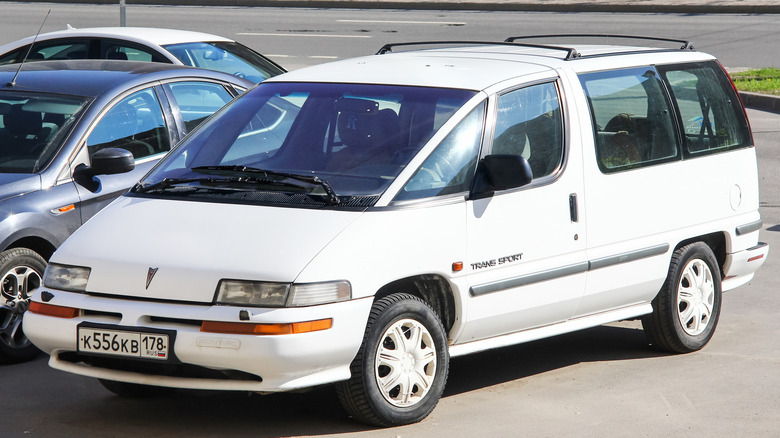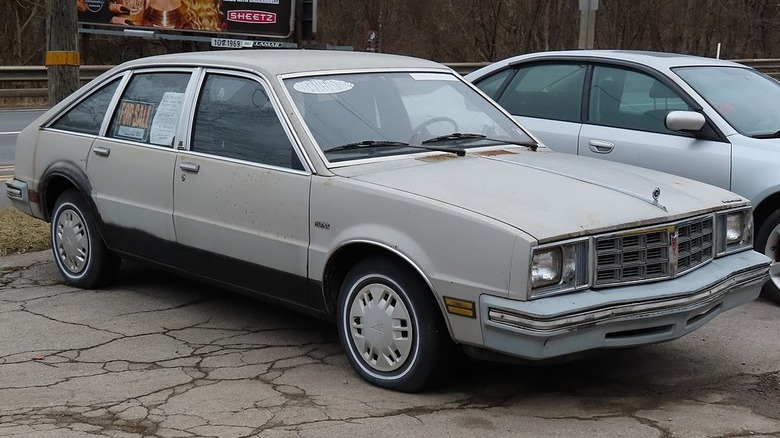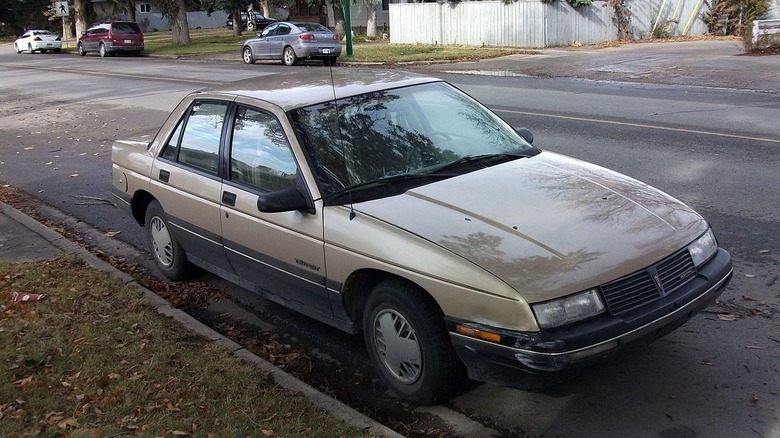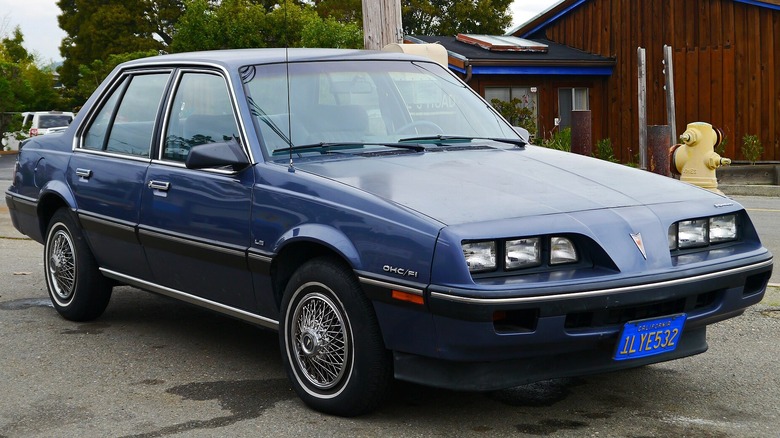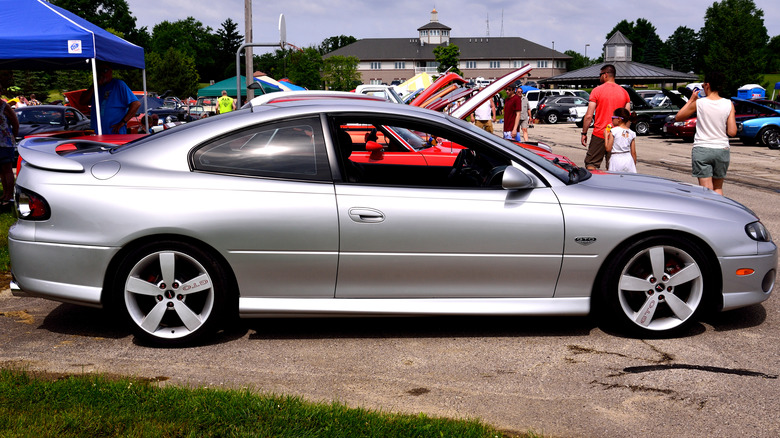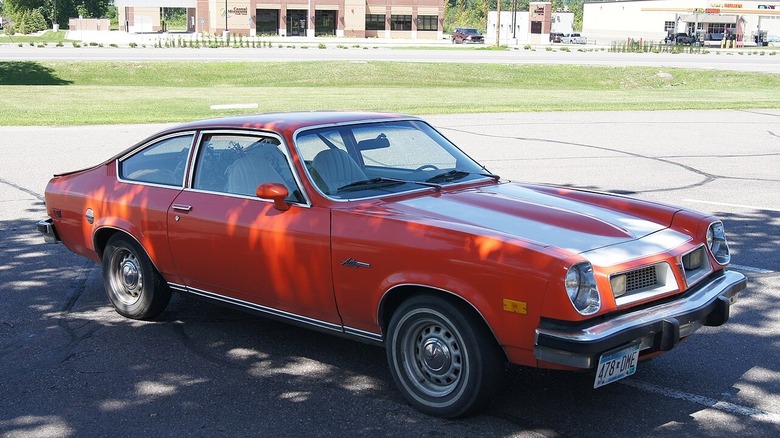8 Of The Worst-Looking Pontiacs Ever Made
Pontiac is one of the most legendary American car builders of all time. From 1926 to 2008, it churned out some of the most legendary automobiles ever. Sadly, changing times nailed Pontiac's coffin closed not long after the millennium, but the auto manufacturer has left the car world plenty of models to enjoy, pore over, and judge.
Gearheads assign great importance to performance, but design is just as important, if not more important. An ugly car won't sell the way a beautiful one will, regardless of performance (well, to a certain degree). And while Pontiac built some of the coolest-looking models ever made, not every one was a slam dunk. Over 82 years, there was bound to be a few duds.
While we appreciate the beauty and art of the automotive world, sometimes it can be fun to dive into the ugly side of things and sift through some of the most dated, unattractive, and poorly conceived cars ever to roll off the Pontiac assembly line.
Join us as we journey down memory lane in search of some of the worst-looking Pontiac models ever made.
2001 to 2005 Aztek
You'd be hard-pressed to find an article about ugly Pontiacs without the Aztek on it. The car is legendary for its poor aesthetic reception, but is it possible that the maligned Aztek was simply ahead of its time?
Many of the most beautiful cars in the world look like a million bucks while performing like a dirty penny. Pontiac flipped the form-over-function formula on its head when it debuted the Aztek for the 2001 model year.
The Aztek caught enormous flak from its introduction at the Detroit Auto Show. Its chunky, plastic-clad design evoked a minivan and military vehicle crossover. Grey cladding, a short hood, oddly shaped rear windows, and a sloping snout for a front end made it appear like some wild creature snuffling through the undergrowth of some distant jungle.
The Aztek's designer, Tom Peters, told MotorTrend back in 2014 that the vehicle was born from asking, "What would happen if we put a Camaro and an S10 in a blender?" It's an odd question, and an odder vehicle. However, it often goes unmentioned that the Aztek was an early progenitor of one of the most popular vehicle classes today: the crossover SUV.
SUVs were nothing new in 2001 — the vehicle genre had been knocking around arguably since Willys sent its first Jeeps to the U.S. Army. But what the Aztek brought to the table with its mix of minivan, hatchback, and SUV was one of the earliest crossovers to hit the market.
1984 to 1988 Fiero 2m4
The 1980s were dark days for the car world. Reeling from the gas crises of the 1970s, manufacturers made up for a lack of performance by building some of the most stunningly ugly cars in existence. Enter the Pontiac Fiero 2m4.
The Fiero arrived in two flavors: The coupe 2m4 model and the fastback GT. The GT model somehow pulled off sleek and muscular, but the 2m4 evoked a JV wrestler who wasn't quite ready for varsity. Its flat platform rear — replete with luggage rack and thin cosmetic spoiler — utterly ruined whatever charm the GT brought to the table.
Pontiac vice-president Bill Hoglund is the man responsible. Seeking a two-seat "sports" car that could double as a commuter, he pushed the production of what would become one of Pontiac's most misunderstood vehicles.
Pontiac offered a pair of transverse engines mounted and crammed into a tiny compartment that all but eliminated an amateur's ability to do virtually anything to the engine without pulling it. Perhaps worse, the 2.5-liter base four-cylinder made only 98 hp, though a 2.6-liter V6 upgrade brought that number up to the 140-hp range. Performance-wise, it was out-punched by the Fox-body Mustang of the same era, and the Mustang offered the luxury of passenger seats.
Frankensteined together from the parts bins of other GM projects, the Fiero never found its footing, and it slipped away after the 1988 model year.
1990 to 1996 Trans Sport
The 80s weren't just the decade of Culture Club and Gordon Gekko. In 1984, Dodge and Plymouth introduced an all-new form of kid-hauler: the mini-van. Vans had long been in vogue for transporting goods, but the Caravan and Voyager presented consumers with a family-friendly choice geared toward being the go-to for family road trips.
Never to be outdone by the likes of Mopar, General Motors turned its attention to the mini-van market. Pontiac debuted a futuristic concept at the Chicago Auto Show in January 1986. Dubbed the Trans Sport — like transportation, but also, uh, sporty — the concept caught enough attention to enter full production for the 1990 model year.
The main problem with the Trans Sport is how terribly it has aged. The production model had decidedly less glass than the futuristic concept, but the bones were there. A sweeping windshield sloped down to an enormous front overhang, giving it the appearance of an overbite, and all the curves and angles seemed to be in precisely the wrong places.
The Trans Sport design is 30 years old at this point, and it suffers from a common flaw of "futuristic" designs: Today, it looks far more like something from the '80s than anything we'd call timeless.
1980 Pontiac Phoenix
Mini-vans weren't the only things happening in the 1980s. Not to be confused with the flaming bird logo on the Pontiac Firebird, the Pontiac Phoenix was short-lived and quickly forgotten.
Produced over two generations between 1977 and 1984, the Phoenix was a compact platform that offered everything from coupes to four-door hatchbacks. The advent of front wheel drive inspired a drivetrain switch when Pontiac introduced the second generation in 1980 (shown above).
With a design that looked like a blend of the Volkswagen Kubelwagen, the doomed Chevrolet Chevette, and an ancient ground sloth, the four-door hatchback (shown above) was a standout for all the wrong reasons.
Contributing to Pontiac's woes, the second-gen Phoenix was built on the ill-fated X-body platform. The Phoenix rose from the ashes of the first generation with a redesigned body that was marginally less ugly by '80s standards, but the flaws of the X-body, including poor build quality, faulty parts, bad brakes, and poor performance, doomed it as surely as any aesthetic flaws would have.
Poorly engineered and hated by the industry, the Phoenix melted into the past after the 1984 model year having failed in its mission to take on the influx of compact imports flooding the market.
1987 to 1991 Tempest
The ethos of 1980s automobile design leaves no shortage of ugly Pontiacs to choose from. Perhaps the biggest shame about this iteration of the Tempest is the stark contrast it presents to the historic nameplate. The original Tempest featured one of the best engines ever put in a Pontiac and had a great run in the heyday of the muscle era, before bowing out in 1970. The 1980s version was a far cry from that.
Unfortunately, some bright minds at Pontiac thought it would be a great idea to slap the name on the Chevrolet Corsica and sell it in Canada as a Tempest between 1987 and 1991. The era is not known for its high design ideals, especially in budget compact sedans, and the entire endeavor is little more than an insult to the memory of the mighty Tempest name.
The Canadian Tempest came in two trims: Base and LE. Shelling out for the upgraded trim wouldn't save the car's looks. The lines were boring, and plastic abounded. Pontiac would have been better off simply calling this the Pontiac Car because that's what it looks like: a generic rattletrap that qualifies as an automobile by virtue of its four wheels, engine, and steering wheel.
1984 Sunbird Sedan
Speaking of generic sedan design, the often-forgotten Sunbird was also a misstep for Pontiac. The second generation Sunbird, also known as the J2000, hit the streets for the 1982 model year. It was part of a broader GM effort to shift from rear- to front-wheel drive. J-platform cars rolled off the assembly lines at Pontiac, Chevrolet, Buick, Oldsmobile, and even Cadillac.
The front end lifted directly from the third-generation Firebird parts bin should tell you what you need to know about the Sunbird. Unfortunately, no beefy V8 lurked behind those headlights. In an effort to give the Sunbird some pep, Pontiac introduced a turbo-charger that boosted horsepower from 84 to 150. It was a huge leap in power and a decent number for the time, but it wasn't enough to push the Sunbird past grocery-getter status.
It seems clear that the Sunbird team's design decisions were based on economics rather than passion or performance. The 1985 model arrived largely unchanged, and carried its legacy of chunky and awkward design until it ceased production in 1994.
The Sunbird also made attempts to be sporty, offering a coupe and a ragtop version. These efforts to inject some excitement into the Sunbird's design are commendable, but unfortunately, they were not enough to salvage its uninspired appearance.
2004 to 2006 GTO
The Pontiac GTO was one of the coolest muscle cars ever to grace the open road. Maybe that's why it's such a shame that the reboot was so plain. The American muscle car renaissance was getting into full swing at the opening of the millennium, but alas, Pontiac missed the party.
In the early-aughts, the beleaguered General Motors brand was on the verge of getting the ax. But as it hurtled toward annihilation, Pontiac spat out a last-gasp GTO that looked more like a sixth generation Grand Prix than anything else — unless you're familiar with the Holden Monaro.
Between 1968 and 1977, the Monaro captured the attention of the Australian market in two- and four-door iterations. When Holden decided to resurrect it after an enthusiastic reception to a concept at the 1998 Sydney Motor Show, auto executive legend Bob Lutz (responsible for the fan-favorite Dodge Viper) saw an opportunity.
Pontiac glommed onto the Monaro. The performance side was hunky-dory: an available 350 hp 5.7-liter LS1 V8 later upgraded to a 400 hp 6.0-liter LS2 V8 gave it plenty of punch. That was a ton of power for the 2003 to 2006 era. Yet something was lacking.
A name like GTO deserved its own design team with a look to the past. Slapping a V8 (albeit a respectable one) into someone else's car wasn't a formula that would pique the interest of GTO enthusiasts. It's not that the new GTO was ugly per se, it just deserved better.
1976 Astre
Automakers' attempts to retain the characteristics of the muscle glory days in the fuel-crunch of the late 1970s created some awkward cars, though you can almost see the lineage Pontiac was chasing with the Astre. It retains some of the attributes of the Camaros and Firebirds of the time, but it's far more apparent that this car shared blood with the hated Chevy Vega.
The Vega/Astre design took root after Ralph Nader's infamous book Unsafe at Any Speed helped murder the Chevrolet Corvair. GM needed a new compact and turned to its Advanced Chevrolet Design Studio. The original sketches show a speedier-looking take on a European-inspired design. Alas, what ultimately hit the market in 1970 lacked much of the sleek charm of the sketches.
Pontiac took the Vega, renamed it the Astre, and shoved it onto the Canadian market in 1973. It was a bare-bones, spartan subcompact that rusted out just as quickly as its Chevrolet equivalent. Unfortunately, that was the only thing the Astre did quickly. Underwhelming 2.3- and 2.5-liter in-line four cylinders managed to move the ugly little coupe around. Those were thirsty days for those accustomed to drinking from the hose that was the muscle car revolution in the late 1960s and early 1970s.
Not content to subject only Canadians to the miserable eyesore that was the Astre, Pontiac brought it to the American market in 1975. Mercifully, the Astre died an early death in 1977. Few examples remain, blissfully saving us from accidentally looking at it on the street.
